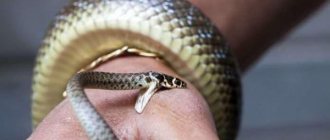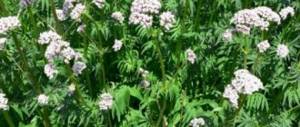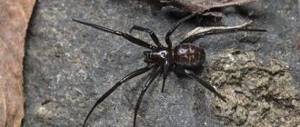Tarantulas are large, poisonous wolf spiders. This means that the animal hunts, unlike its relatives, most of which feed on prey caught in trapping nets. He needs the web only for arranging the nest.
For food it catches insects and small vertebrates, which it kills with poison. Tarantula bites of any kind are poisonous, so in this case a person experiences quite strong and unpleasant sensations, and some may develop an extremely violent allergic reaction.
Large spider of the genus Tarantula
Tarantula Information
Tarantulas are large representatives of the spider genus. They are poisonous and prefer to live in steppes and deserts. Rarely, the holes that tarantulas dig for themselves can be found in forest and steppe zones. These spiders spend the daytime in their earthen burrows. At night they go out hunting. Their diet consists of various small insects.
Tarantulas do not weave trapping nets, but use the web to strengthen the walls of the burrow and also to form a cocoon for eggs. To a lesser or greater extent, all types of tarantulas are poisonous. The glands that produce poison are located in the cephalothorax area of the spider. During a tarantula attack, the muscle fibers covering the gland contract and the venom is injected into the victim's body. Tarantula venom is transparent and has an oily consistency.
Lifestyle
Under natural conditions, representatives are found in deserts and steppes and lead an active nocturnal lifestyle. During the daytime they hide in burrows. Many species are also used by people as pets. To maintain them, it is necessary to create suitable conditions and maintain optimal parameters of temperature, humidity, and feeding period.
IMPORTANT! Some exotic species are very difficult to adapt to living conditions at home. It is worth considering this when deciding to purchase them as a pet.
The danger of a tarantula bite
All tarantulas are poisonous, but the perceived danger of a bite depends on the individual characteristics of the spider. These features include the age of the arthropod, gender (females are much more aggressive, but their toxicity is lower than that of males), season and a number of other factors. For example, at the beginning of their activity, after winter, spiders are not particularly aggressive.
Note! In the last month of spring, the period of females laying eggs begins. The activity of tarantulas increases, the toxicity of their toxic substance increases by more than 2 times. In June, the mating period begins, so toxicity increases another 3 times. With the onset of autumn, before the start of winter, the toxicity of the poison is reduced.
The habitats of tarantulas in Russia are the south of Siberia, as well as the steppe area south of Saratov, Tambov, and Orel. The South Russian tarantula is also found in Belarus and Ukraine. Its bites cause unpleasant symptoms in humans, but toxic substances penetrating through damaged skin are not life-threatening. Tarantula bites are dangerous for people suffering from allergic reactions.
In appearance, a tarantula bite resembles a hornet or wasp bite. At the site of the bite, small dots are marked, located at a distance of 0.3-1.5 cm from each other. These are traces of spider chelicerae.
Appearance and features
Photo: Poisonous tarantula spider
The entire body of the spider is covered with small hairs. The structure of the body is divided into two main parts - the abdomen and the cephalothorax. There are 4 pairs of eyes on the head, 2 of which are small and arranged in a straight line, the rest form a trapezoid by their arrangement.
Video: Tarantula spider
This placement allows you to see everything around in a 360-degree view. In addition to a well-developed visual apparatus, tarantulas have a hypersensitive sense of smell. This gives them the opportunity to smell prey at fairly large distances.
The sizes of arthropods are quite large:
- body length - 2-10 cm;
- leg length - 30 cm;
- females weigh up to 90 g.
Like other insects, female spiders are significantly larger than males. Throughout their lives, individuals molt several times. The more often this happens, the faster they age. On four pairs of long, hairy legs, the spider moves comfortably across sand or water surfaces. The forelimbs of males are more developed than those of females.
Interesting fact: The limbs can only bend, so the wounded individual becomes weak and vulnerable. The legs bend thanks to the flexor muscles, and extend under the pressure of the hemolymph. The skeleton of arachnids is also weak, so any fall could be their last.
Chelicerae (mandibles) are equipped with poisonous ducts. Thanks to them, arthropods can defend themselves or attack. The color of spiders is usually gray, brown or black. Sexual dimorphism is well developed. American tarantulas are considered the largest. Their European counterparts are significantly smaller in size.
Symptoms of a tarantula bite
In order to quickly respond to a spider attack and take measures to eliminate the consequences, you need to know the main symptoms. It is especially important to know the signs of a spider bite for people with high allergies. With increased sensitivity, a person has 2-5 minutes before the full clinical picture appears.
A reaction to a tarantula bite for a person who does not suffer from allergies is manifested by the following symptoms:
- the appearance of symmetrically located small dots on the skin, from which a light yellow liquid flows (ichor, or lymph);
- hyperemia of the skin at the site of the bite and around it;
- an increase in local body temperature by several degrees;
- severe pain at the site of the bite;
- the appearance of edema at the site of the lesion.
At the moment of an earth spider attack, a person feels a sharp and acute pain.
After the spider injects a toxic substance, the victim may experience an attack of nausea, dry mouth and dizziness. Vomiting and abdominal pain are also noted.
For those who suffer from allergic reactions, the symptoms will be slightly different. The main features are:
- the occurrence of swelling in the lips, tongue, nose and eyes;
- the development of severe itching and burning in the affected area, which does not disappear even after a person takes antihistamines;
- severe swelling at the site of the bite;
- numbness in the affected area, be it a leg, arm, finger or other part of the body;
- eruption of gastric contents, stool upset;
- decreased blood pressure and increased heart rate;
- increased drowsiness and general malaise;
- problems in the functioning of the speech apparatus;
- difficulty breathing, inability to fully inhale and exhale;
- loss of consciousness.
When an ordinary person takes psychostimulants, hallucinogenic drugs and alcohol, the reaction to a tarantula bite will be the same as in people with allergies.
Population and species status
Photo: Tarantula spider
Tarantulas are most common in forest-steppe, steppe and desert areas. Their numbers are gradually decreasing every year, but over the past ten years, wolf spiders have managed to stop the process of population decline and even stabilize it. Climate warming has had a beneficial effect on this.
One of the main reasons for the decline in arthropod numbers is commercial activity. In third world countries, arachnids are caught in order to sell them for little money and earn food. In countries with less developed economies, there has been a significant decline in the number of tarantulas.
From 1995 to 2004 in the Republic of Tatarstan, the species was recorded in the Nizhnekamsk, Elabuga, Zelenodolsk, Tetyushsky, Chistopol, and Almetyevsk regions, where its appearance was recorded from 3 to 10 times. Mostly, individuals are found alone.
Tropical forests are being cut down at a significant rate due to population growth. In Bolivia and Brazil, artisanal methods of gold and diamond mining are used, which destroys the soil. Water is pumped underground, as a result of which the integrity of the earth's surface is damaged. This, in turn, leads to negative consequences for the existence of the animal world.
First aid for a tarantula bite
A tarantula cannot kill a person. People who do not suffer from allergies do not need special treatment. Help will consist in promptly washing the wound surface. Clean running water is suitable for rinsing, which will avoid infection. You can use a soap solution.
It is advisable to treat the wound with an antiseptic - hydrogen peroxide, chlorhexidine, if such medicines are on hand.
In order to relieve swelling, you can use a cold compress of ice or other product in the freezer.
If you have a severe allergic reaction to the bites of poisonous insects and spiders, a more responsible and serious approach will be required. First of all, you need to take care of proper breathing. It is recommended to remove all clothing from the victim's upper body to eliminate additional pressure on the chest.
You need to give the person bitten plenty of water to drink. It is advisable to take antihistamines (Suprastin, Tavegil, Claritin, etc.).
After providing first aid, it is important to see a doctor as soon as possible. In an emergency, you must call an ambulance.
What is contraindicated to do if you are bitten?
It is important to know what you can do if you are bitten by a tarantula, and what actions are strictly contraindicated. Thus, it is not recommended to cauterize the bite site with alcohol or alcohol-based antiseptics. Such manipulations are not only ineffective, but can also increase pain.
Important! It is strongly recommended not to cut the lesion on your own.
This can lead to infection with pathogenic bacteria and the development of complications. In case of severe itching and burning, scratching the affected area is also contraindicated due to the risk of introducing microbes.
Social structure and reproduction
Photo: Poisonous tarantula spider
The period of sexual activity occurs in the last month of summer. The male weaves a web, after which he begins to rub his belly against it. This provokes ejaculation of seminal fluid, which flows onto the web. The male plunges his pedipalps into it, which absorb sperm and become ready for fertilization.
Next comes the stage of searching for a female. Having found a suitable candidate, the male emits vibrations with his abdomen and performs ritual dances, which attracts females. They lure out hiding females by tapping their paws on the ground. If the partner reciprocates, the spider inserts its pedipalps into her cloaca and fertilization occurs.
How to avoid a tarantula bite?
It is important to know not only first aid measures for a tarantula bite. It is necessary to take all necessary measures to prevent an attack and subsequent bite from an arthropod.
There is an opinion that tarantulas are aggressive. In fact, spiders of this species rarely attack humans unless there are special reasons. As a rule, females attack, protecting their burrow from outside interference, especially if there are eggs or small spiders there. It is possible to prevent a tarantula attack, and to do this you need to follow a number of the following rules:
- while on vacation, avoid places where there are a large number of various cracks in the ground, dead wood and stones;
- close the tent at night;
- When at the dacha or in a tent, constantly inspect your shoes for spiders or other insects.
Children should not be allowed to take tarantulas out of their holes and walk barefoot on dry grass. These spiders are unusually agile, despite the fact that they look large and clumsy. Especially you should not tease a female with spiders on her back.
Prevention
To prevent a spider from biting a tarantula, you do not need to pester it. Do not stir up holes where insects live. Curiosity and a consumerist attitude towards nature are fraught with trouble. Even if the insect does not pose a danger to humans, the threat remains for children and people with hypersensitivity to poisons.
The main prevention of bites is the use of repellents on country holidays and while traveling. In case you have to treat a tarantula or other insect bite, you should prepare a first aid kit. Antiseptics, antipruritic ointments, NSAIDs in the form of gels and creams, and antihistamines will be useful on the road.
For those who breed exotic insects in a terrarium, it is worth recalling the safety rules. Arthropods are not left unattended, they are not allowed to “walk” around the room, and the conditions of detention are monitored. Also, the terrarium must be safe. Typically, products made from reinforced glass with a secure door design are chosen. Only one individual is kept in one terrarium, otherwise fights will begin between insects.
Range, habitats
The South Russian tarantula is the most impressive spider that lives in the vast territory of the former Soviet Union. Lycosa singoriensis lives in the Caucasus, Central Asia, Ukraine and Belarus (where it was spotted in the floodplains of the Sozh, Dnieper and Pripyat rivers in 2008).
In our country, it is distributed almost everywhere: residents of the Tambov, Oryol, Nizhny Novgorod, Saratov, Belgorod, Kursk and Lipetsk regions find it in their garden beds.
The spider is found in large quantities in the Astrakhan and Volgograd regions (especially near the Volga), as well as in the Stavropol Territory. The tarantula has long been “registered” in Crimea, after which it managed to crawl to Bashkiria, Siberia and even to the Trans-Baikal Territory.
The South Russian tarantula loves arid climates, often settling in steppe, semi-desert and desert zones (with access to natural bodies of water). Villagers encounter the spider in fields, garden plots, orchards (during potato harvest) and on hillsides.
Treatment
The most dangerous reaction to poison is respiratory arrest. If there is a suspicion of an acute allergic reaction, seek the help of a resuscitator. Injections of adrenaline and epinephrine solution allow the victim to return to life. At all stages of medical care, heart rate and breathing are monitored. If a tarantula or karakurt has bitten, diphenhydramine is used, and an aqueous solution of aminophylline is indicated to relieve symptoms of respiratory failure.
A tarantula bite rarely leads to serious consequences, and therefore traditional treatment does not require the use of potent drugs. For many centuries it was believed that a special dance, the tarantella, allows one to recover from the consequences of a tarantula bite. This opinion was never shared by doctors. There is no healing power in dance movements with an accelerating rhythm. This is an ordinary legend, which over many centuries has acquired unrealistic details.
The tarantula itself is not a poisonous spider, and its bite is not dangerous for humans. However, patients with hypersensitivity may require infusion detoxification. To maintain electrolyte balance, glucose drips are prescribed. In severe cases, cardiac medications may be required. If the victim suffers severe poisoning, he is prescribed glucocorticosteroids. Typically, serious reactions occur against the background of existing diseases of the central nervous system and cardiovascular system.
Home content
I would like to note right away that the South Russian tarantula is quite aggressive, fast, and will not tolerate mistakes in handling it. I would advise keeping a South Russian tarantula at home only to experienced keepers who have already had experience handling fast and aggressive tarantula spiders. According to some reports, the South Russian tarantula can jump to a height of 10-15 centimeters in an attempt to protect itself and its home.
The South Russian tarantula is often kept at home; it is a rather interesting and unpretentious spider. Keeping a South Russian tarantula at home can be compared to keeping burrowing species of tarantula spiders, at least in some respects.
The terrarium for the South Russian tarantula should be chosen in a vertical orientation, and a fairly large layer of substrate should be poured there, about 10-15 centimeters. Coconut substrate can be used as a substrate; earth, a mixture of earth and clay, and so on, can also be suitable.
We invite you to read: Tarantula spider: a scary monster or a pet?
Be sure to install a drinking bowl with clean and fresh water in the terrarium with the South Russian tarantula; it will provide an acceptable level of humidity and give the spider access to drinking water.
The South Russian tarantula should be fed with food insects of a suitable size, approximately the size of a spider's body, excluding its paws. Many owners of the South Russian tarantula feed it with insects from the street; if I were them, I would refuse such feeding, for the reasons stated in the articles: “Feeding tarantula spiders” and “Diseases of tarantula spiders, the fungus Cordyceps militaris.”
From the natural life cycle of the South Russian tarantula, it seems to me that it needs wintering from autumn to spring, but I did not find such information in articles about the content of this tarantula on the Internet. I think wintering can be simulated by placing a tarantula in the refrigerator, or similar methods; if you decide to keep it at home, be sure to consider this issue in more detail.
The spider was brought from the village and planted in a small (35*20*25 cm) aquarium. I poured a 3-5 cm layer of soil at the bottom and placed a lid from a jar as a pool.
According to recommendations on the Internet, the tarantula needs to be filled with more soil so that it can dig holes, but for now I limited myself to this layer, because... an aquarium half covered with soil will be too heavy, and in this case this is important.
At first, the tarantula sat motionless, and with all its appearance made it clear that nothing in this world could excite it. Even three bread ground beetles released into the aquarium did not make any impression on him... as long as the light was on.
Without waiting for anything interesting, I went to bed. A few minutes later there were sounds of some kind of fuss and even knocks on the glass. I jumped up, shined a flashlight... The spider was sitting in the same place, however, in its chelicerae a ground beetle was now helplessly moving its legs.
By morning, the position of the spider had not changed, but part of the soil in the aquarium was now covered with a layer of cobwebs, and only sucked shells remained of two more ground beetles.
But the tarantula's hunt for flying food is especially impressive. Actually, I think that in keeping such a spider, feeding is the most interesting and exciting spectacle. The speed with which the tarantula grabs its prey never ceases to amaze me.
If you decide to keep a South Russian tarantula at home, then remember that it is quite fast and does not tolerate mistakes in handling. When trying to defend itself, it can jump to a height of about 15 cm and will certainly bite.
As for the content itself, the South Russian tarantula is unpretentious. He needs:
- a vertical terrarium from which the spider cannot escape on its own;
- a fairly thick layer of substrate - at least 30 cm, so that your pet can dig its holes in it;
- a drinking bowl that will contain clean and fresh water every day, and the spider should have free access to it;
- food – for the South Russian tarantula I usually buy food insects, the body size of which should correspond to the body size of the spider itself.
Nutrition
The South Russian tarantula feeds on food insects that do not exceed the size of its body (excluding limbs).
What to feed
The list of products for a pet tarantula includes:
- cockroaches (Turkmen, marbled, Argentine, Madagascar and others);
- zofobas and mealworm larvae;
- crickets;
- pieces of minced beef (low fat).
Crickets, as a rule, are bought at a pet store or at a poultry market, since, unlike cockroaches, they are difficult to breed at home: when hungry, crickets easily devour their comrades.
Once a month, multivitamins are mixed into the meat ball, and calcium gluconate is added once every two weeks. The raw “meatball” is given to the spider directly into its paws.
The following are prohibited:
- domestic cockroaches (they may be poisoned);
- street insects (they may be infected with parasites);
- mice and frogs (cause the death of house spiders).
If, despite the warnings, you are going to pamper your pet with insects from the street, catch them away from noisy roads and the city. It would not hurt to inspect the insect to detect parasites and wash it with water.
Insect predators, such as scolopendra, praying mantis or other spiders, will be unsuitable food for the tarantula. In this case, your furry pet may be the prey.
Feeding frequency
Newly born spiderlings are fed newborn worms and tiny crickets.
Growing tarantulas feed twice a week, adults - once every 8-10 days. The remains of the feast are immediately removed from the arachnaria.
A well-fed spider stops responding to food, but sometimes it is necessary to stop feeding in the interests of the tarantula itself. A signal of sufficient filling of the abdomen is its increase (1.5-2 times) in relation to the cephalothorax. If feeding is not stopped, the tarantula's abdomen will rupture.
Feeding tips
Don't panic if the spider doesn't eat. Tarantulas can fast for months without harm.
If your pet doesn't eat the insect right away, crush the second one's head and leave it in the terrarium overnight. Was the loot still intact by morning? Just throw the insect away.
After molting a spider, it is better not to feed it for several days. The period of abstinence from food is calculated by adding 3-4 days to the number of molts.
Do not leave insects unattended in the arachnaria to avoid possible problems: the female cockroach may give birth, and you will be looking for nimble cockroaches scattered around the apartment.











